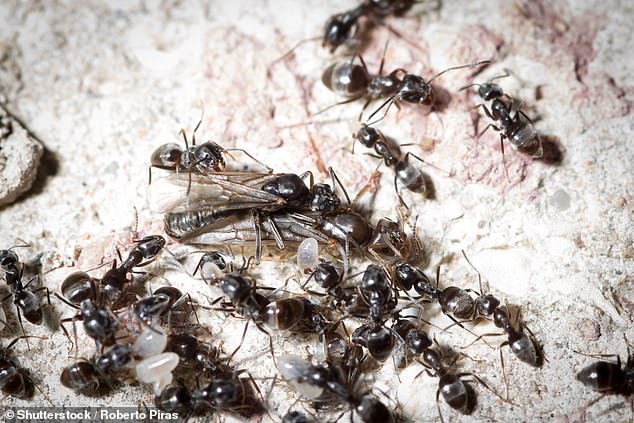-
READ MORE: British gardeners warned over stowaway snakes and spiders
Brits should be on the lookout for an invasive ‘super ant’ that’s storming through Europe, experts warn
The species, called Tapinoma magnum, is native to the Mediterranean region – but has swiftly moved further north into
France
,
Germany
and Switzerland.
The pest tunnels under roads and bites through electric cables, causing power cuts, internet
outages
, and thousands of pounds in damage.
Anyone who squashes a T. magnum ant is greeted by the stench of rancid butter,
the Sun
reports.
So far, there have been no verified records of T. magnum in the UK – but experts say the species could potentially cross the
English channel
.
‘There’s always some risk with species like this,’ Niall Gallagher, technical manager at British Pest Control Association (BPCA), told MailOnline.
‘Like any invasive species, if T. magnum were to establish here, it could become a nuisance.
‘They form vast supercolonies, displace native species and can even cause structural issues by excavating under paving.’
T. magnum is native to north African and Mediterranean countries, including Algeria, Morocco, Tunisia, Spain and Italy.
But in the last few years the species has reached further northwards into France, Belgium, Germany, Switzerland and the Netherlands.
According to Mr Gallagher at the BPCA, the ants spread north mainly through horticultural imports – especially potted plants and trees from the Mediterranean.
They have ‘remarkable cold tolerance’, surviving harsh German winters, and can thrive in disturbed, urban environments – such as patios, pavements and garden centres.
Worryingly, T. magnum forms ‘supercolonies’ of 20 million ants across 60 acres due to a ‘tireless determination to expand’, the Sun reports.
When two colonies encounter one another, they merge together ‘in alliance’ rather than attacking – gradually forming one massive colony with multiple queens.
They build their nests in the ground and as a result displace the earth beneath tarmac – causing roads and pavements to sink.
In the German city of Kehl, the supercolonies led to disruptions to power and internet connections as the insects bit through electric cables.

A Kehl playground had to close last summer because the Tapinoma ants had completely tunneled under the entire area,
SRF
reports.
Meanwhile, in Switzerland, where the species was first discovered in 2018, T. magnum has caused a ‘plague’ of the beasts in Zurich.
In the nearby Oetwil an der Limmat region, one supercolony infested a potato field the size of about seven football pitches.
A local, Agnes Wirth, told SRF: ‘There were so many ants, you couldn’t see the floor anymore.’
T. magnum are black in colour, measure an average of 3 mm (0.1-inch), and look very similar to the black garden ant (Lasius niger), according to the BPCA.
Although even experts may struggle to tell the two species apart on appearance alone, T. magnum can be discerned by a distinctive ‘procession’ behaviour.
A colony of the invasive ants forms conspicuous trails across pavements and up buildings, often in large, coordinated lines.
To the untrained eye, this may look like a very active colony of black garden ant, but the sheer volume and organised movement can be a telltale sign of T. magnum.

If the species were to establish in the UK, pest professionals would likely rely on a combination of bait gels (such as indoxacarb or imidacloprid) and surface treatments, as successfully done in Zurich.
‘Individual efforts by homeowners and gardeners can’t control an infestation,’ said Mr Gallagher.
‘Specifically tailored pest control solutions are needed to eradicate a colony.’
Although spread mainly through imported plants, climate change may also be playing a role in helping the ants survive further north than previously possible.
Warmer winters and longer summers in the UK could make colonisation here more likely, just like with several ‘alien’ species.
‘Tapinoma magnum has profound impacts on local communities,’ said Ricardo Pereira, biologist at the Natural History Museum Stuttgart.
‘With progressive global warming and a warmer spring, more alien species will follow.’
Read more











